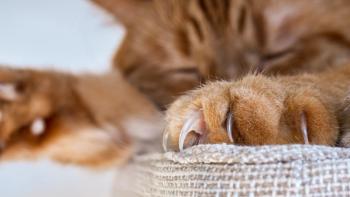
How to tame Catzillas: Human-directed aggression in our furry feline friends
The much feared ferocious kitty is really just misunderstood. Let's examine the spark behind the fury and take steps to alleviate the anxiety.
It's all a matter of perspective when it comes to aggression in cats. (Photo by Getty Images)Everyone who has owned or treated a defensive or overplayful or high-strung cat knows the look-the dilated pupils, the ears pinned to the head, the swishing tail, the crouched position and the low menacing growl. Cats are capable of doing some major damage to their humans or pet housemates when overstimulated. What do you do with a cat with an aggression problem?
Immediate control measures
An attack is imminent-or in progress. How should you coach cat owners on how to effectively intervene?
What owners cannot do. When behavior needs to be interrupted, of course, we always emphasize to owners not to hit their cats. But cats are pretty emotionally fragile too, so I recommend that we tell clients that you shouldn't yell at cats either. These harsh interventions are not acceptable and will just make the problem worse, damaging the emotional bond between the owner and the cat. They can also be quite dangerous.
What owners can do. In most situations, avoidance is the most prudent choice. Calmly walk away and leave the cat on its own to chill out.
Acceptable methods to interrupt a cat's unwanted behavior might involve responses that are minimally direct such as sprays of air or water or unpleasant noises. And when a client uses these methods, no eye contact should occur between the client and the cat so that the deterrent stimulus is associated with the cat's behavior rather than with the client. The decision to use any response that might be aversive will depend on the cat's temperament. Aversives should be avoided with fearful or sensitive cats. If anything the owner does significantly stresses the cat, it could become more aggressive.
Long-term solutions
Now that the cat owner has dealt with an immediate incident, she's hopefully approached you about how to prevent further rampages. You get to step in and save the household! First, rule out medical causes, even if you have to anesthetize the patient just to do your diagnostic due diligence. Make sure to rule out things that cause pain, such as dental disease, abscesses, otitis, musculoskeletal problems, pancreatitis and cystitis, as well as things that cause behavior alterations, such as hyperthyroidism and cognitive dysfunction.
What you do from there depends on what you diagnose as the type of aggression each patient is exhibiting.
Pain-related aggression-“Ouch! Don't touch me!”
It is pretty obvious why pain can cause aggression in cats. Take care to minimize discomfort during handling. In some cases, analgesics might be needed.
You can help new kitten owners prevent this one in the first place by emphasizing that handling kittens at an early age is the key. Habituation, desensitization and counterconditioning exercises that are done when the pet is a kitten will make things easier for everyone and may increase the cat's tolerance for being handled when it is uncomfortable or in mild pain later in life. Instruct the family and their friends to gently handle various parts of the cat's body while it is being hand-fed. As days go by, the family should increase the intensity and variety of handling. Although the effects of all painful stimuli cannot be anticipated, a cat that is trained to be relaxed during a variety of types of handling should be more likely to tolerate handling when it is in pain or anxious. Make sure to tell clients to do this early in life because the socialization period starts decreasing at about 7 weeks of age in cats.
Fear aggression-“Get that away from me!”
For cats that are fear-aggressive, you need to identify the stimulus and threshold of anxiousness before aggression rears its ugly head. Usually in cats, this is a distance threshold. To treat, you can let the cat just avoid the stimulus if possible. If it is not possible, you need to use desensitization and counterconditioning techniques. For more on how to do that with cats and a few other helpful cat-specific techniques, listen to my audio clip here:
If you determine medication is needed, I recommend starting with a selective serotonin reuptake inhibitor (SSRI), such as fluoxetine or paroxetine at a dosage of 0.5 to 1 mg/kg orally once daily. Tricyclic antidepressants and other types of medications can be used if SSRIs fail to help.
Handling a feral cat that is scared of everything? That's a whole different story. Listen to this audio clip for some tips:
Play aggression-“Are you ready to roughhouse?!”
While not truly a type of social aggression, feline play attacks can be quite frightening, and even damaging, to the family. If the attacks are quiet, stealthy attacks not accompanied by vocalization, you're probably dealing with play behavior. Cats that are predisposed are young, from a single-cat household, spend a lot of time alone or have a family member that encourages rough play. The good news is that if it is a mild case, the cat will probably grow out of it.
But sometimes you have someone with fragile skin or who is immunocompromised, diabetic or on anticoagulant therapy in the household. Owners will also want solutions if the behavior is nocturnal and the owner is sleep-deprived or if the behavior is directed toward a passive, fearful pet in the house.
This situation is just about the only one in which I commonly recommend adopting another cat if they can-one of similar age and temperament. Otherwise, they need to keep the cat worn out-recommend that they provide lots of physical exercise, stop inappropriate play but engage the cat in lots of appropriate play, and interrupt the behavior as described above. Environmental enrichment in the form of increased perching spots, kitty condos, kitty gardens, food-dispensing toys and treat treasure hunts can also be helpful.
Redirected aggression-“Gah! There's nothing I can do!”
The definition of redirected aggression is targeted, aggressive behavior against a different stimulus than the one that caused it to be aroused. The most common cause for this stimulus is territorial. And affected cats can stay in an aroused state sometimes for long periods. These attacks can be very unpredictable and cause serious injuries. For unknown reasons, the bite pressure seems to be very uninhibited in these cats.
Treatment involves removing the pet's access to the aggravating stimuli if possible and modifying the response to the stimuli. If the pet becomes highly aroused when it goes outdoors, it should be confined indoors. If it becomes aroused watching outdoor cats through the windows, that opportunity should be removed. SSRIs may help reduce the animal's response to stimuli. Desensitization and counterconditioning can sometimes be effective for changing the cat's response to arousal stimuli.
Newsletter
From exam room tips to practice management insights, get trusted veterinary news delivered straight to your inbox—subscribe to dvm360.






